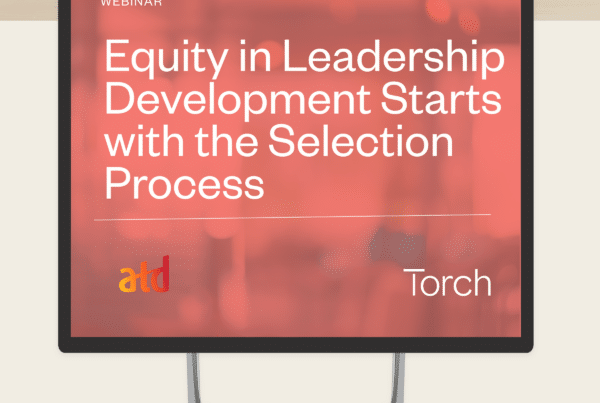At Torch we see the impact that leadership coaching and mentoring have on individual growth and development every day. There’s a special connection forged between a coach or mentor and their client, and it’s something everyone should get a chance to experience.
That’s why we’re passionate about ensuring that access to leadership coaching and mentoring is an equitable process for organizations. Creating diverse coaching and mentoring cohorts is an important first step.
This article was created with the support of Torch’s Customer Success team, who have years of experience facilitating the cohort creation process with our customers. We created a list of 5 questions to consider to help you build a diverse coaching or mentoring cohort.
1. What selection process are you using to build your cohort?
The most common selection processes for building cohorts are manager-led, leader-led or a hybrid of both. Manager-led selection asks a company’s managers to nominate participants. Leader-led allows anyone to self-nominate. A hybrid involves both manager and self-nominated participants.
Consider if the process you’re using could be contributing to bias. Are managers nominating only those who look like them, have the same conflict-resolution style, or socio-economic background? Are the people who are self-nominating all from one office? Looking at similarities of potential participants from both of your selection pools can help you fine tune those communications to solicit more diversity.
While it’s helpful to have criteria on what types of leaders you’re looking for (like senior leaders with a 2+ year tenure) ensure your criteria do not have inherent bias that could discourage some people from nominating others or self-nominating.
2. Is there a feeling of safety around nominations?
Your work and team environment should support people of all backgrounds taking up opportunities to get involved in coaching or mentoring. For example, if part of the development opportunity includes spending time in leadership workshops or with a coach, will the environment (manager, team etc.) be supportive of this time being taken? Is this support being given equally to all leaders?
If you’re using an opt-in model, do leaders feel safe to nominate themselves? There can be much vulnerability in self-nominating.
Think of this in the way that workplaces lacking in diversity need to approach hiring for diversity. Is the first woman hired to a company going to feel safe and included? Is the first woman considering nominating themself to a development opportunity when all past participants have been men going to feel safe and supported in doing so? Their feelings of safety are going to be influenced by the communications sent out related to the nomination process, and the work and team environment at large.
3. Who comes to mind when considering high potential talent?
How your company defines high potential talent will inform who comes to mind when you consider who might be nominated to participate in a leadership coaching or mentoring program.
According to Harvard Business Review, “High potentials consistently and significantly outperform their peer groups in a variety of settings and circumstances. While achieving these superior levels of performance, they exhibit behaviors that reflect their companies’ culture and values in an exemplary manner. Moreover, they show a strong capacity to grow and succeed throughout their careers within an organization—more quickly and effectively than their peer groups do.”
When considering who in your company consistently and significantly outperforms their peers, oftentimes you’ll look at previous projects that exemplified a person’s ability to outperform others. However, have those opportunities been given out equitably?
For example, a manager might not assign a challenging project to a team member who works flex hours because they are a parent. This would make it harder for this employee to rise to the occasion.
We’ll finish the answer to this question with another question for you: Who is getting the opportunities to become a high potential employee? If ‘cultural fit’ is used as an indicator for high potential talent, we encourage you to unpack that designation and explore what it means for someone to be a ‘cultural contributor’ instead.
4. Are the people in your cohort from different offices or locations?
The main consideration here is the link to culture. If you’re a global organization with offices in India, Latin America and Europe for example, but all of your leaders are based in India, why is that? Some cultures favor extroverted and loud leaders, others are more partial to leaders that are quiet and humble. Are you taking these cultural differences into account when you’re selecting leaders for your development programs?
If you’re a small company, this may not be as much of a consideration as if you have hundreds of locations across the world. Either way, take a look at how many people in your cohort are from the same physical location, and see if that has further implications for the culture of leadership that is valued at your company.
If you’re planning pilots based on location, give more weight to some of the other considerations on this list.
5. Are the people in your cohort representing different demographics?
Common demographics covered by diversity and inclusion reports include: age, gender, race, ethnicity and sexual orientation. When reviewing potential participants for your cohort, map out the representation you have across these five common demographics. If it turns out, for example, your group is all men over 30, you might considering seeking out more applicants.
This is when it’s helpful to revisit question #1 – your selection process. If it’s purely manager-led, have a conversation with your managers about expanding the people they are considering for this development opportunity. If it’s leader-led, is there something in your communications that could be changed to encourage different people to apply?
When it comes to diversity by the numbers, we looked at the High Tech industry, since Torch is based in the Bay Area, a hub of High Tech companies. This industry drastically employs a smaller number of Black people, about 14-7% according to data from a US Equal Employment Opportunity Commission report. Among Executives in the Bay Area specifically, 57 percent of employees were white, 36 percent were Asian American, 1.6 percent were Hispanic and less than 1 percent were African American.
In preparing for this piece, we considered one big question with an even bigger answer: How do you build a diverse cohort if you don’t have a diverse company? The answer is to start taking the steps towards building a diverse company. Let employees know that this is important work that won’t happen overnight, but you’re committed to it.
We created Justice at Work, a new Slack-based community, to provide a dedicated space for discussing social justice and diversity at work. It’s a place to ask questions and get support on your journey, no matter the stage you’re at now. We invite CEOs, HR and L&D leaders to join.


